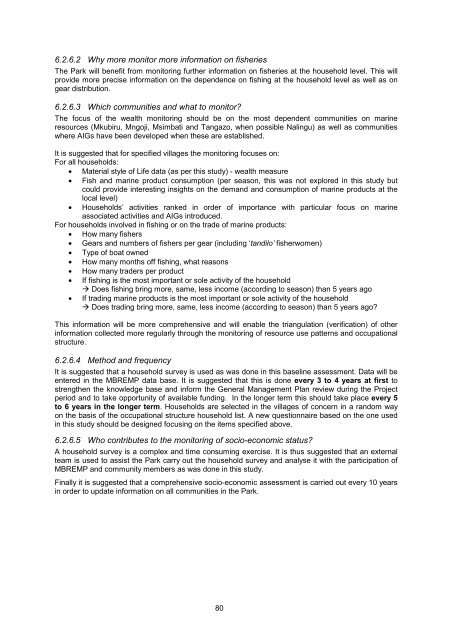a socio-economic baseline assessment of the mnazi bay - IUCN
a socio-economic baseline assessment of the mnazi bay - IUCN
a socio-economic baseline assessment of the mnazi bay - IUCN
You also want an ePaper? Increase the reach of your titles
YUMPU automatically turns print PDFs into web optimized ePapers that Google loves.
6.2.6.2 Why more monitor more information on fisheries<br />
The Park will benefit from monitoring fur<strong>the</strong>r information on fisheries at <strong>the</strong> household level. This will<br />
provide more precise information on <strong>the</strong> dependence on fishing at <strong>the</strong> household level as well as on<br />
gear distribution.<br />
6.2.6.3 Which communities and what to monitor?<br />
The focus <strong>of</strong> <strong>the</strong> wealth monitoring should be on <strong>the</strong> most dependent communities on marine<br />
resources (Mkubiru, Mngoji, Msimbati and Tangazo, when possible Nalingu) as well as communities<br />
where AIGs have been developed when <strong>the</strong>se are established.<br />
It is suggested that for specified villages <strong>the</strong> monitoring focuses on:<br />
For all households:<br />
• Material style <strong>of</strong> Life data (as per this study) - wealth measure<br />
• Fish and marine product consumption (per season, this was not explored in this study but<br />
could provide interesting insights on <strong>the</strong> demand and consumption <strong>of</strong> marine products at <strong>the</strong><br />
local level)<br />
• Households’ activities ranked in order <strong>of</strong> importance with particular focus on marine<br />
associated activities and AIGs introduced.<br />
For households involved in fishing or on <strong>the</strong> trade <strong>of</strong> marine products:<br />
• How many fishers<br />
• Gears and numbers <strong>of</strong> fishers per gear (including ‘tandilo’ fisherwomen)<br />
• Type <strong>of</strong> boat owned<br />
• How many months <strong>of</strong>f fishing, what reasons<br />
• How many traders per product<br />
• If fishing is <strong>the</strong> most important or sole activity <strong>of</strong> <strong>the</strong> household<br />
Does fishing bring more, same, less income (according to season) than 5 years ago<br />
• If trading marine products is <strong>the</strong> most important or sole activity <strong>of</strong> <strong>the</strong> household<br />
Does trading bring more, same, less income (according to season) than 5 years ago?<br />
This information will be more comprehensive and will enable <strong>the</strong> triangulation (verification) <strong>of</strong> o<strong>the</strong>r<br />
information collected more regularly through <strong>the</strong> monitoring <strong>of</strong> resource use patterns and occupational<br />
structure.<br />
6.2.6.4 Method and frequency<br />
It is suggested that a household survey is used as was done in this <strong>baseline</strong> <strong>assessment</strong>. Data will be<br />
entered in <strong>the</strong> MBREMP data base. It is suggested that this is done every 3 to 4 years at first to<br />
streng<strong>the</strong>n <strong>the</strong> knowledge base and inform <strong>the</strong> General Management Plan review during <strong>the</strong> Project<br />
period and to take opportunity <strong>of</strong> available funding. In <strong>the</strong> longer term this should take place every 5<br />
to 6 years in <strong>the</strong> longer term. Households are selected in <strong>the</strong> villages <strong>of</strong> concern in a random way<br />
on <strong>the</strong> basis <strong>of</strong> <strong>the</strong> occupational structure household list. A new questionnaire based on <strong>the</strong> one used<br />
in this study should be designed focusing on <strong>the</strong> items specified above.<br />
6.2.6.5 Who contributes to <strong>the</strong> monitoring <strong>of</strong> <strong>socio</strong>-<strong>economic</strong> status?<br />
A household survey is a complex and time consuming exercise. It is thus suggested that an external<br />
team is used to assist <strong>the</strong> Park carry out <strong>the</strong> household survey and analyse it with <strong>the</strong> participation <strong>of</strong><br />
MBREMP and community members as was done in this study.<br />
Finally it is suggested that a comprehensive <strong>socio</strong>-<strong>economic</strong> <strong>assessment</strong> is carried out every 10 years<br />
in order to update information on all communities in <strong>the</strong> Park.<br />
80
















